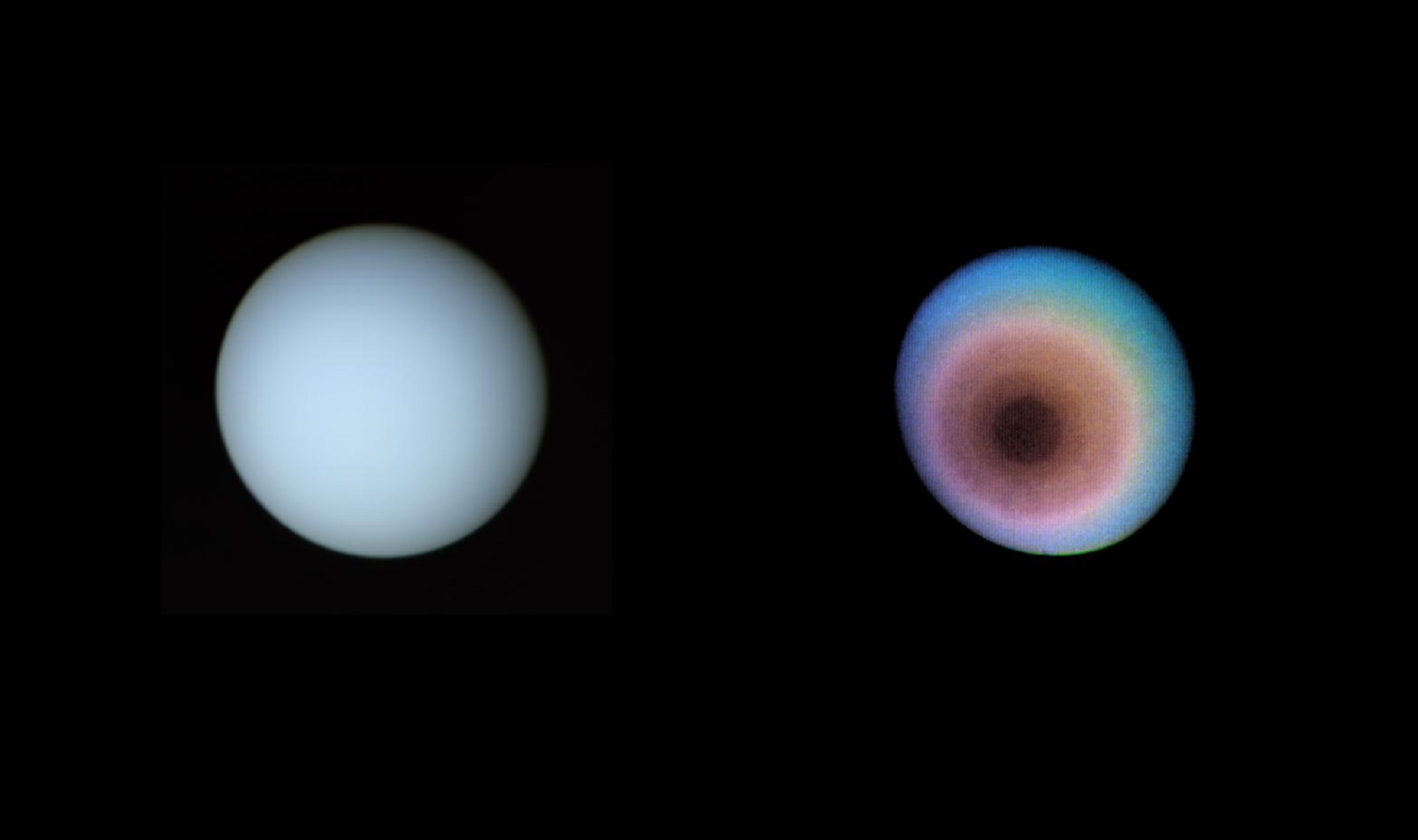

Everyone loves a good Uranus crack—the mere mention of its name can draw snickers in a serious science class. But the sideways planet has a surprisingly respectable backstory that few people know.
How did Uranus get its name?
Uranus (officially pronounced yur-un-us) was the god of the sky in ancient Greece, but actually was not the first choice for the seventh planet’s name. The ice giant was discovered by British astronomer William Herschel in 1781, and finally recognized as a planet at that time. It had been seen in the night sky for millennia, but people simply assumed it was another star. “There were many observations of the position of Uranus before its discovery as a planet,” says Bonnie Buratti, planetary scientist at NASA’s Jet Propulsion Laboratory.
Herschel thought his new celestial trophy should be called Georgium after King George III, the reigning king of England at the time. Astronomers from other countries weren’t too happy with this choice, though, so they proposed a number of alternatives. A year later, German astronomer Johann Bode suggested the winning name, Uranus, the Latin word for the Greek god Ouranos. He made quite a persuasive argument with two main points. First, King George would stand out in a very strange way from the other planetary names, all based on ancient gods. Second, Saturn is the father of Jupiter in mythology, and Uranus’s Roman counterpart (Caelus) is the father of Saturn, making a neat hierarchy in the order of the planets. The element uranium was named in 1789 in support of Bode’s proposed title for the planet.
[Related: How old is Earth?]
It is a bit strange, however, that Uranus is the only Greek god amongst a planetary neighborhood full of Romans. It’s unclear if this was a mistake—maybe Bode didn’t know the Roman equivalent of Ouranos was actually Caelus—or if 18th-century astronomers simply preferred the Greek version of the name.
Such mistakes don’t really happen nowadays, as the International Astronomical Union (IAU) meticulously oversees the naming of celestial discoveries (and has done so since its founding in 1919), from whole new objects to detailed features on planets’ surfaces.
“The IAU is the sole authority for official names for solar system objects,” says Tenielle Gaither, database manager for the U.S. Geological Survey Gazetteer of Planetary Nomenclature. Chuck Wood, Wheeling University scientist and member of the IAU Working Group on Planetary Nomenclature, adds, “the IAU is the only international body that is concerned with astronomy, and every professional astronomer and nation accepts their authority.”
How do astronomers choose names today?
When a new body in space needs a label, the IAU committee for that kind of object gets to work. Planetary scientists can suggest names, but the ultimate authority still rests with the IAU, which has specific themes for each planetary system and kind of feature. Exoplanets, for example, are named after the star they orbit or the telescope that found them (like 51 Pegasi b or Kepler-16b), followed by a lowercase letter assigned in order of discovery. Meanwhile, comets are named after their discoverers plus a standardized number, like 1P/Halley. Asteroids, on the other hand, are named by their discoverers (not after their discoverers), and can be a reference to anyone or anything as long as it’s not inappropriate. “An asteroid [363115 Chuckwood] is named after me, so I passed the bar,” says Wood.
The IAU also maintains a list of categories for every planet and its moons in the solar system. The six largest known rocks that orbit Uranus are borrowed from works of Shakespeare and Alexander Pope: Puck, Miranda, Ariel, Umbriel, Titania, and Oberon. The features on these satellites have even more individualized naming conventions. For example, all the cracks, crevasses, and craters on Puck must be named after mischievous Puck-like spirits. On Miranda, names come from characters and places in Shakespeare plays.
Just like in Herschel’s time, some proposals can stir up debate and drama. “You might think that deciding on names would be a dry, humdrum activity,” says Wood. “But it has often been contentious, starting with the US and Soviet naming of lunar features in the early [space race].” He’s been cursed at by other scientists, threatened with appeals to the president of the United States, and more, simply for insisting that names adhere to the IAU’s established rules.
There is a lot of beauty in planetary naming, too. “While IAU nomenclature is first and foremost a tool for scientists to discuss surface features clearly and unambiguously in the literature, some names certainly have personal significance,” says Gaither, whose favorite planetary feature name is Morrison crater on Mercury, which she helped propose. “I read most of Toni Morrison’s novels in my late teens and early 20s, and they were pivotal in developing my understanding of the tragedy of Black women’s lived experiences of racism, sexism, and poverty,” she adds.
[Related: How long does it take to get to Mars?]
In recent history, astronomical names have expanded from ancient gods of Western societies and works of famous white authors to now include important figures and landmarks from other cultures. Arguably the best-known example is the suspected interstellar comet 1I/2017 U1 ‘Oumuamua: Its name is Hawaiian for “a messenger from afar arriving first” because it was discovered with a telescope located atop Haleakala volcano on Maui.
A scientific name can capture history, culture, bureaucracy, and more. With Uranus, it captures people’s endless appreciation for bathroom humor, even though it’s not really pronounced that way.
Correction (July 7, 2023): Due to an editing error, this story incorrectly stated that the Haleakala volcano is located on the big Island of Hawai’i. It is on Maui.